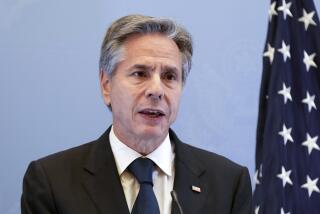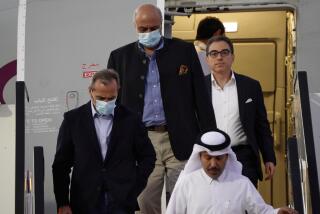Disputed Iran Funds Caught in Complex Web
- Share via
WASHINGTON — It is a system that only a team of lawyers could devise and only Rube Goldberg could love: a complex international structure complete with scores of attorneys, dozens of translators and bank accounts in New York, Algeria, London and the Netherlands.
Since its creation in 1981, the Iran-U.S. Claims Tribunal has labored in relative obscurity to resolve billions of dollars in claims involving Iranian assets.
But with U.S. hostages in Lebanon once again in the headlines--and with Iranian officials hinting that once-frozen Iranian assets should be part of any deal to bring the hostages home--the tribunal and the assets it handles are once again in the public eye.
Many Misconceptions
Unfortunately, the complexity of the system is almost matched by the misconceptions surrounding it.
Perhaps the most common misconception--one that the Iranians often appear to be fostering--is that somewhere in the United States, a single bank account holds large amounts of money belonging to Iran that could be returned as part of one huge deal.
Once, that was true. On Nov. 14, 1979, after militant Iranian students had seized the U.S. Embassy in Tehran, President Jimmy Carter issued an executive order freezing Iranian government assets in the United States.
Billions of dollars held in U.S. banks by Iran’s national airline, its atomic energy commission, its central bank and other government bodies were seized.
Fourteen months later, as part of the deal that freed the American hostages held at the embassy, the U.S. and Iranian governments agreed in Algiers to turn disputes involving most of the money over to a nine-judge international claims tribunal in The Hague, the Netherlands. After the Supreme Court upheld the agreement, the United States released the Iranian funds, nearly $10 billion.
A large part of that money--$3.89 billion--went directly to Iran. The rest, along with the prodigious interest it earns, has been the province of the claims tribunal ever since.
The system is cumbersome, involving multiple rounds of briefings and arguments, decisions that must be translated into both English and Persian and a payment plan that requires an escrow agent in Algiers to instruct bankers in the Netherlands to release funds to the Federal Reserve Bank in New York before claimants actually get their checks.
But despite initial skepticism about whether the panel would give U.S. claimants a fair shake, the court has won relatively high marks from lawyers. So far, the judges have issued awards for nearly $1.3 billion to more than 380 U.S. claimants ranging from American schoolteachers, who sued Iran for back pay and airline tickets they had been promised, to Phillips Petroleum, which recently won $110 million in a dispute involving oil drilling claims.
Far more complicated than the private claims are disputes between the two governments. While most of the private claims involve U.S. citizens suing Iran, most of the government-to-government claims involve Iran suing the United States. The going has been slow.
The largest single Iranian claim involves military equipment that had been purchased, but not delivered, during the regime of the late Shah Mohammed Reza Pahlavi. Iran in the past has claimed that the equipment was worth $10.8 billion.
The military supplies included much of what a well-stocked army might want--circuit boards and vacuum tubes, helicopters, missile parts, ammunition. Much of the equipment has been stored in warehouses for years. But the largest single items, four frigates built for the shah’s navy, were turned over to the U.S. Navy, which jokingly refers to them as “Ayatollah class” cruisers. The four--the Kidd, the Scott, the Callaghan and the Chandler--are all on active duty.
In 1981, the claims tribunal ruled that the United States had no obligation to give Iran the arms. But the United States is obliged, the judges decided, to give Iran its money back. Since then, the two sides have been arguing over how much the equipment is actually worth. U.S. lawyers have argued that much of the equipment is obsolete and should be depreciated from its original value. Iranian representatives have argued that the equipment should be valued at something approaching what it would cost to replace it, a much higher sum.
Eventually, if left to its own procedures, the tribunal will resolve those questions. Many experts, however, believe that long before it does, a negotiated settlement of the dispute is likely to become one element of renewed relations between the United States and Iran.
IRAN’S FROZEN ASSETS: A BREAKDOWN
After the seizure of American hostages at the U.S. Embassy in Tehran in 1979, the United States broke relations with Iran and froze billions of dollars of Iranian assets; Iran also seized U.S. assets.
When Iran freed the hostages in January, 1981, the Iran-U.S. Claims Tribunal was set up in The Hague to resolve the economic disputes between the two countries.
Claims have been made by banks, companies, individuals and governments, and the tribunal has resolved billions of dollars worth of claims.
Total Iranian assets transferred out of U.S. banks in 1981: $9.975 billion.
Of the total:
$3.89 billion went directly to Iran
$1 billion was held by NV Settlement Bank of the Netherlands as a security account for claims by U.S. nationals and the U.S. government against Iran and by Iranian nationals and the Iranian government against U.S.; Iran must replenish that account when it falls below $500 million.
From NV Settlement Bank account:
--$1,278,000,000 was awarded to U.S. nationals on 384 claims.
--$118 million was awarded to Iranian nationals on 4 claims.
--2,559 private claims and 36 government-to-government claims remain, amounting to several billion dollars on either side.
$3.667 billion was held by Federal Reserve Bank of New York to cover claims by bank syndicates on loans to Iran.
$1.418 billion was held by Bank of England to cover claims by individual banks not in syndicates.
Of the totals in those two banks:
--$4.9 billion was awarded to the banks, including interest.
--$504 million was returned to Iran.
--$812 million remains in the two accounts, pending further litigation.
More to Read
Sign up for Essential California
The most important California stories and recommendations in your inbox every morning.
You may occasionally receive promotional content from the Los Angeles Times.











